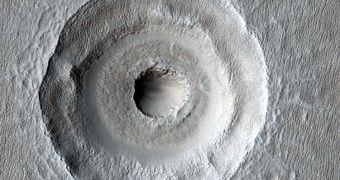Scientists operating the NASA Mars Reconnaissance Orbiter (MRO) spacecraft were recently surprised when it sent a new series of photos back to Earth. One of them showed a massive impact crater on the Red Planet that was apparently caused following a devastating cosmic collision, most likely with an asteroid. The thing about this particular crater is that it has a very weird internal structure, which has never been noticed in other similar features. Researchers at NASA are currently scrambling to make sense of it, Space reports.
Geologists are also wondering about the unusual subsurface layering that can be seen in the new photos. A central pit exists at the bottom of the crater, which some believe may have been caused by a secondary impact. However, instances in which two asteroids or meteorites impact a target in the same place are very rare. Usually, space rocks fall relatively close to each other, but seldom right on top of one another. But studying the complex feature is made easy by the fact that those photos were collected using MRO's High Resolution Imaging Science Experiment (HiRISE) camera.
This instrument has over the years provided hundreds of thousands of pictures of Mars, each of them at incredible resolution levels. The camera is almost single-handedly responsible for allowing NASA to image about 1 percent of the entire Martian surface. The same level of detail is also visible in the recent view it took of the weird crater. “Impacts into layers of alternately strong and weak material – for example, ice rich versus non-ice-rich – produce terracing such as that seen between the inner pit and the outer rim,” said in a statement HiRISE science team member Sarah Milkovich. She is based at the University of Arizona.
“Uneven sublimation and periglacial erosion of exposed ice-rich material in the interior of the crater may explain why the small central pit is slightly offset from center relative to the terrace and rim of the larger crater. It has a raised rim, which is characteristic of impact craters and is difficult to explain with a layered target. While no ejecta from this later impact can be seen, the ejecta could have been removed by extensive periglacial modification. Additionally, the floor fill around the inner crater resembles impact ejects elsewhere at this latitude, and some of the 'landslides' to the East could be flow-back of ejecta off the walls of the larger crater,” Milkovich says.

 14 DAY TRIAL //
14 DAY TRIAL //